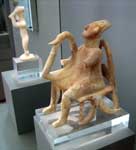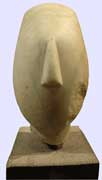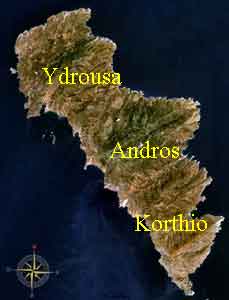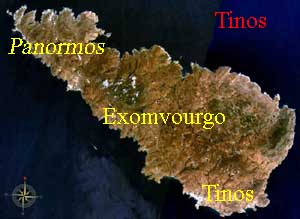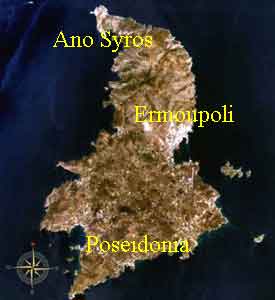.
Periphery: South Aegean
Prefectures : Cyclades, Dodecanese
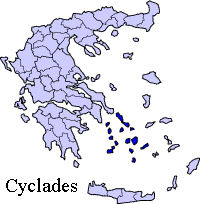
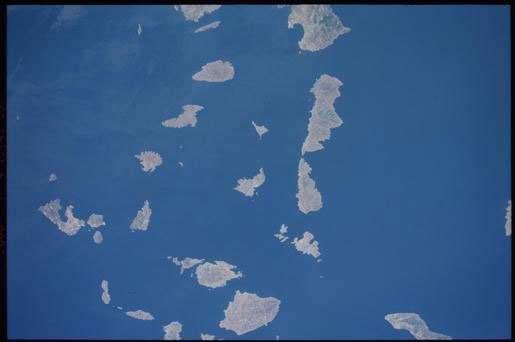
NASA Image of the Cyclades
The Cyclades, from the Greek Κυκλάδες, ("circular," modern Greek Kikládhes) is an island group south-east of the mainland of Greece. It is a part of the vast number of islands which constitute the Greek archipelago in the Aegean Sea. The name was originally used to indicate those islands that formed a rough circle around the sacred island of Delos (map).
The Cyclades are comprised of around 220 islands, with the major ones being Amorgos, Anafi, Ándros, Antiparos, Delos, Ios, Kéa, Kimolos, Kithnos, Mílos, Mykonos, |Náxos, Páros, Pholegandros, Serifos, Sifnos, Sikinos, Síros, Tínos and Santorini (Thira).
Ermoupolis, on Síros, is the chief town and administrative center of the group. The islands are peaks of a submerged mountainous terrain, with the exception of two volcanic islands, Melos and Santorini (Thera). The climate is generally dry and mild, but with the exception of Naxos the soil is not very fertile: agricultural produce includes wine, fruit, wheat, olive oil, and tobacco. Cooler temperatures are in higher elevations and mainly do not receive wintry weather. In transportation, the Cyclades is the only prefecture in Greece that is not linked with a state-maintained highway or a highway number. All of its roads in the island complex are secondary or provincial.

View of the Aegean sea from the island of Santorini
History
The significant Late Neolithic and Early Bronze Age Cycladic culture is best known for its schematic flat female idols carved out of the islands' pure white marble centuries before the great Middle Bronze Age ("Minoan") culture arose in Crete, to the south: these figures have been looted from burials to satisfy a thriving Cycladic antiquities market since the early 20th century.
A distinctive Neolithic culture almalgating Anatolian and mainland Greek elements arose in the western Aegean before 4000 BC, based on emmer wheat and wild-type barley, sheep and goats, pigs, and tuna that were apparently speared from small boats (Rutter). Excavated sites include Saliagos and Kephala (on Keos) with signs of copper-working, Each of the small Cycladic islands could support no more than a few thousand people, though Late Cycladic boat models show that fifty oarsmen could be assembled from the scattered communities (Rutter), and when the highly organized palace-culture of Crete arose, the islands faded into insignificance, with the exception of Delos, which retained its archaic reputation as a sanctuary through the period of Classical Greek civilization.
Archaeology
The first archaeological excavations of the 1880s were followed by systematic work by the British School at Athens and by Christos Tsountas, who investigated burial sites on several islands in 1898-99 and coined the term "Cycladic civilization" Interest lagged, then picked up in the mid-20th century, as collectors competed for the modern-looking figures that seemed so similar to sculpture by Jean Arp or Constantin Brancusi. Sites were looted and a brisk trade in forgeries arose, but more accurate archaeology revealed the broad outlines of a farming and seafaring culture that had immigrated from Asia Minor ca 5000 BC. Early Cycladic culture evolved in three phases, between ca 3300 - 2000 BC, when it was increasingly swamped in the rising influence of Minoan Crete. The culture of mainland Greece contemporary with Cycladic culture is termed Helladic.
In recent decades the Cyclades islands have become extremely popular with European and other tourists, and as a result there have been problems with erosion, pollution, and water shortages.
Click Image to enlarge
Area codes
- 22810 - Syros, including Kythnos, Serifos islands
- 22820 - Andros
- 22830 - Tinos
- 22840 - Paros and Sifnos islands
- 22850 - Amorgos and Naxos islands
- 22860 - Folegandros, Ios, Santorini and Sikinos islands
- 22870 - Kimolos and Milos
- 22880 - Kea Island
- 22890 - Mykonos
Municipalities and communities
| Municipality | YPES code | Seat | Postal code | Area code |
|---|---|---|---|---|
| Amorgos | 3101 | Amorgos | 840 08 | 22850-2 |
| Andros | 3103 | Andros | 845 00 | 22820-2 |
| Ano Syros | 3105 | Ano Syros | 841 00 | 22810-8 |
| Drymalia | 3107 | Chalkio | 843 02 | 22850 |
| Ermoupoli | 3109 | Ermoupoli | 841 00 | 22810-2 |
| Exomvourgo | 3108 | Xinara Naxou | 842 00 | 22850-5 |
| Ios | 3112 | Ios | 840 01 | 22860-9 |
| Kea | 3113 | Kea
(aka Gia, Tzia or Keos) |
840 02 | 22880-2 |
| Korthio | 3115 | Ormos Korthiou | 845 02 | 22820-6 |
| Kythnos | 3117 | Kythnos | 840 06 | 22810-3 |
| Milos | 3118 | Milos | 848 00 | 22870-2 |
| Mykonos | 3119 | Mykonos | 846 00 | 22890-2 |
| Naxos | 3120 | Naxos | 843 00 | 22850-2 |
| Paros | 3123 | Paros | 844 00 | 22840-2 |
| Poseidonia | 3124 | Episkopi Posidonias | 841 00 | 22810-4 |
| Serifos | 3125 | Serifos | 840 02 | 22810-5 |
| Sifnos | 3127 | Sifnos | 840 03 | 22840-3 |
| Thira | 3111 | Thira | 847 00 | 22860-2 |
| Tinos | 3129 | Tinos | 842 00 | 22830-2 |
| Ydrousa | 3130 | Gavrio | 845 01 | 22820-7 |
| Community | YPES code | Seat | Postal code | Area code |
| Anafi | 3102 | Anafi | 840 09 | 22860-6 |
| Antiparos | 3104 | Antiparos | 840 07 | 22840-6 |
| Donoussa | 3106 | Donoussa | 843 00 | 22850-5 |
| Folegandros | 3131 | Folegandros | 840 11 | 22860 |
| Irakleia | 3110 | Irakleia | 843 00 | 22870-7 |
| Kimolos | 3114 | Kimolos | 840 04 | 22870-5 |
| Koufonisi | 3116 | Koufonissa | 843 00 | 22870-7 |
| Oia | 3121 | Oia | 847 02 | 22860-7 |
| Panormos | 3122 | Panormos | 842 01 | 22830-3 |
| Schoinoussa | 3128 | Schoinoussa | 843 00 | 22870-7 |
| Sikinos | 3126 | Sikinos | 840 10 | 22860-5 |
|
Municipalities and communities of the Cyclades Prefecture
Amorgos | Andros | Ano Syros | Drymalia | Ermoupoli | Exomvourgo | Ios | Kea | Korthio | Kythnos | Milos | Mykonos | Naxos | Paros | Poseidonia | Santorini | Serifos | Sifnos | Tinos | Ydrousa | Anafi | Antiparos | Donousa | Folegandros | Irakleia | Kimolos | Koufonisi | Oia | Panormos | Schoinoussa | Sikinos |
- West Cyclades News" : West Cyclades News Portal (in Greek Language)
- Jeremy B. Rutter, "The Prehistoric Archaeology of the Aegean" : especially Lessons 2 and 4: chronology, history, bibliography
History
Jeremy B. Rutter, "The Prehistoric Archaeology of the Aegean" (http://projectsx.dartmouth.edu/classics/history/bronze_age/index.html): especially Lessons 2 and 4: chronology, history, bibliography
Further reading
- J. A. MacGillivray and R. L. N. Barber, editors, The Prehistoric Cyclades (Edinburgh) 1984.
- R. L. N. Barber, The Cyclades in the Bronze Age (Iowa City) 1987.
| Ancient Greece
Science, Technology , Medicine , Warfare, , Biographies , Life , Cities/Places/Maps , Arts , Literature , Philosophy ,Olympics, Mythology , History , Images Medieval Greece / Byzantine Empire Science, Technology, Arts, , Warfare , Literature, Biographies, Icons, History Modern Greece Cities, Islands, Regions, Fauna/Flora ,Biographies , History , Warfare, Science/Technology, Literature, Music , Arts , Film/Actors , Sport , Fashion --- |
Retrieved from "http://en.wikipedia.org/"
All text is available under the terms of the GNU Free Documentation License



